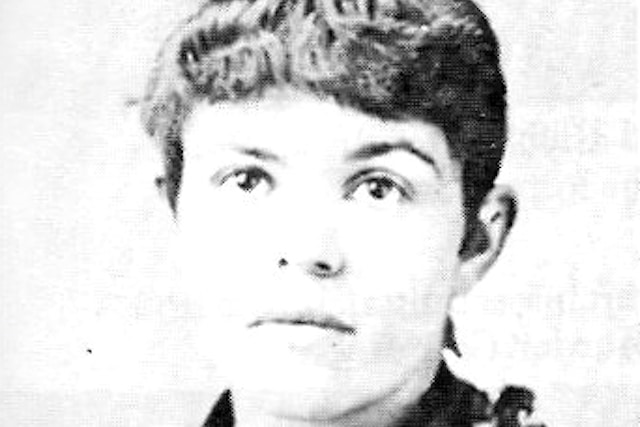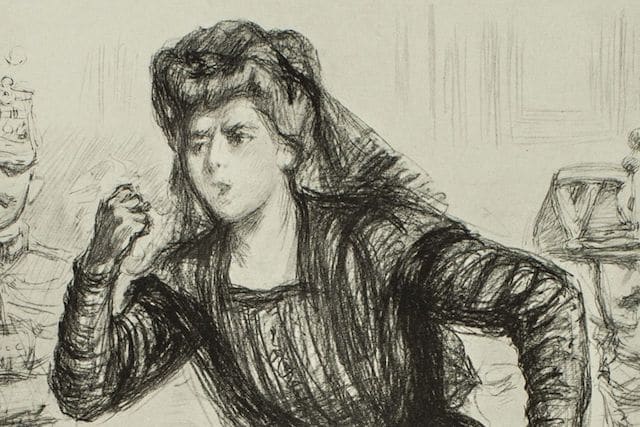Today we take a look at some of the most notorious crimes from history, ones that still lack a definitive answer. This is not the first time we’ve done this and it probably won’t be the last, because the past provides us with a nigh-endless supply of vicious and controversial murders.
10. The Impossible Murder of Julia Wallace
If you are the kind of crime buff who spends their time reading about old unsolved cases, then chances are you have already come across the murder of Julia Wallace, which took place in her home in Liverpool. For lack of a better word, it’s a classic.
On January 19, 1931, William Herbert Wallace went to the Liverpool Central Chess Club to play a few games. There, he had a message waiting for him from a man he did not know named R. M. Qualtrough, who asked him to meet the following night at a certain address to discuss insurance business. Wallace did as he was told, and he went to meet this mysterious stranger, but discovered that the street he was given did not exist.
Coming back home after a wild goose chase, Wallace found both doors to his home locked. This was according to him, but when his neighbors tried the backdoor, it opened right away, and inside the house they saw the body of his wife, 60-year-old Julia Wallace, who had been beaten to death and left in a pool of blood.
Wallace was arrested and charged with his wife’s murder. He was found guilty and sentenced to hang, but the conviction was quashed on appeal. He had a pretty good alibi, after all, having been seen by multiple people that night in different parts of the city. Nobody else was ever charged with Julia Wallace’s murder, and ever since then it has been hailed as a “locked room mystery” and an “impossible murder,” that has puzzled both professional and amateur sleuths alike for almost a century.
9. The Pimlico Poisoning

We are staying in England, but going a bit further back to 1886, when a wealthy, but sickly grocer named Thomas Edwin Bartlett died suddenly of poisoning. His much younger wife, Adelaide Bartlett, was charged with his murder, which she may have committed with the help of an accomplice named Reverend George Dyson. The exact relationship between Adelaide and Dyson has never been established conclusively, but it has been claimed that Mr. and Mrs. Bartlett had a platonic marriage, and that the older husband knew and even approved of his wife’s dalliances.
At first, this seemed like an open & shut case. Inside Bartlett’s stomach, doctors found a lethal quantity of chloroform. Prior to this, Dyson had visited several pharmacies, buying a bottle of chloroform in each one, small enough that he didn’t have to register his name to purchase it.
Everything pointed to Adelaide and her lover poisoning her husband, but there was one thing that did not add up. Thomas Bartlett had no signs of swallowing the chloroform. The substance was a corrosive, and should have left clear marks on the victim’s mouth and throat, but there weren’t any. Only way this could have happened was if Bartlett swallowed the whole chloroform quickly. Because of this, Adelaide’s defense team argued that her husband committed suicide and had drank the poison willingly. The jury bought it and she was acquitted and soon disappeared from the public eye. Plenty remained convinced that she had, in fact, poisoned her husband, although how it was done remains a mystery.
8. The Bigfoot Killer

America seems to have an abundant supply of serial killers. So many, in fact, that while some become infamous like the Zodiac or the Son of Sam, others are destined for obscurity, even though their crimes were no less heinous or violent.
Throughout 1975, Detroit had a murderer on its hands, who targeted prostitutes working in a poor neighborhood known as Cass Corridor. Witness descriptions said the suspect was a tall, muscular black man with an afro, with exceptionally large hands and feet, so he became known as the Bigfoot Killer. He murdered between five and seven victims throughout the year, and then simply disappeared, never to be heard from again.
For a while, it looked like police had a solid suspect in custody. A man named Carl Mayweather had been arrested for an attempted rape and he fit the physical description of the Bigfoot Killer. However, he produced solid alibis for some of the murders, so no further charges were brought against him, and the Bigfoot Killer remains unidentified to this day.
7. The Golfer’s Goodbye

In 1914, English golfer James Douglas Edgar won the Open de France Golf Tour. After World War I, he traveled to North America where he gathered three PGA wins in 1919 and 1920. Add to this the fact that Edgar was also a highly-successful coach and he was on his way to becoming one of the most acclaimed golfers of his era. But the next year, he was struck down under mysterious circumstances, and James Douglas Edgar died aged 36.
On the night of August 8, 1921, three men were walking through the streets of Atlanta, Georgia, when they came across Edgar’s body lying in a pool of blood outside his home. He passed away before the ambulance arrived.
At first glance, it looked like Edgar had been the victim of a hit-and-run. That is the story that became accepted as fact, but many doubt this version. The first to do so was one of the men who found Edgar’s body. His name was Comer Howell and he was a reporter for the Atlanta Constitution. He concluded that the investigation into the golfer’s death was rushed, and that it would have been impossible for Edgar to have been run over by a car because he had no bruises or broken bones. Instead, what he had was one puncture wound to the femoral artery. His inquiries revealed that Edgar was somewhat of a bon vivant, who liked to drink, gamble, and sleep around with married women. His belief was that an angry husband did him in, but we’ll probably never find out for certain.
6. The Tabloid Scandal

At first glance, the murder of Helen Jewett in 1836 did not seem likely to become too memorable. As sad as that was, the death of a prostitute in New York did not usually garner much attention. However, thanks to the newspapers, mainly the New York Herald, it became one of America’s earliest tabloid scandals.
Jewett’s body was discovered by the brothel’s madam, Rosina Townsend, on the morning of April 10, 1836. She had been struck in the head repeatedly with a sharp object, later concluded to have been a hatchet. Afterwards, the bed and the body had been partially set on fire.
The madam accused one of Jewett’s regulars of being the killer, a 19-year-old named Richard Robinson. A quickly-assembled coroner’s jury looked over the scene and agreed with the assessment, so Robinson was arrested and put on trial.
Normally, this sort of crime was destined for the lurid back pages of the penny press, but American entrepreneur James Gordon Bennett decided that it had the right amount of sex, scandal, and violence to become a hit with the readers of the New York Herald, which he had only founded the year prior.
He started by giving the murder a full front page on the Herald, and covered the investigation and the trial extensively, with no detail being too controversial, too gory, or even too fabricated to be included. As far as Robinson was concerned, he was acquitted and left New York soon after and Helen Jewett’s murder was never solved.
5. The Steinheil Affair

Marguerite Steinheil was a woman notorious for having affairs with many powerful men from 19th century France, most famous of all being the French President Félix Faure who, according to legend, might have even died during one of his dalliances with his mistress.
None of that concerns us now, because the Steinheil Affair had to do with murder, not sex. About a decade after her scandalous tryst with the president, police were called to the Parisian home of Marguerite Steinheil on May 31, 1908. Inside, they found her husband and mother murdered, while Marguerite herself had been bound and gagged. According to her, four hooded strangers broke in, tied her up, strangled her family and robbed the place, possibly looking for valuable documents.
Although police initially accepted this story, more and more clues began to suggest that Marguerite Steinheil might have been involved. For starters, her neighbor, who was first on the scene, claimed that Steinheil’s ropes were loosely tied around her hands and should not have been able to hold her. Furthermore, a forensic investigator claimed there was no saliva on the gag which had, supposedly, been forced into Marguerite’s mouth.
Months into the investigation, Steinheil incriminated herself further when she was caught trying to frame two of her servants. This was enough to convince the police to charge her with the murders, but during the trial, she persuaded the jury of her innocence. Even though the judge called her story “tissues of lies,” Marguerite Steinheil was acquitted, and the Steinheil Affair became another unsolved mystery.
4. A Cold Case in Australia

One of Australia’s most notorious unsolved murders occurred on September 19, 1952, when the body of 22-year-old Betty Shanks from Queensland was discovered by an off-duty police officer. She had been badly beaten, strangled, and dumped in a garden in a suburb of Brisbane. What followed was one of the largest criminal investigations in the history of the Australian state, but the murder of Betty Shanks remains, to this day, the longest-running cold case in Brisbane.
Some believed Betty was attacked by a sexual predator, but there were no signs of sexual assault. Others thought that the culprit might have been a jilted lover, but those leads came up empty, too. Multiple people even confessed to the deed, but most of the stronger suspects were, ultimately, eliminated as possibilities, either through alibis or through modern DNA tests.
Police have not released any new information on the case in years. Several crime authors have published books on the subject and they all claim to have identified the killer, but they each mention different people. It remains to be seen if any one of them is actually right.
3. Who Killed Lynne Harper?
One of Canada’s most gruesome and controversial crimes occurred on June 9, 1959, when 12-year-old Lynne Harper disappeared near the air force base in Clinton, Ontario. Her body was found a few days later, with signs of sexual assault and strangulation.
The crime itself was already shocking to the Canadian public, but they got another surprise when the police presented their main suspect – a 14-year-old boy named Steven Truscott. He was one of Lynne’s classmates and on the night of her disappearance, he gave her a ride on his bicycle, thus becoming the last known person to see her alive. Truscott maintained that he dropped Lynne off at an intersection, and then saw her get into a car.
Due to the serious nature of the crime, the 14-year-old was tried as an adult and not only that, but he was found guilty. Steven Truscott was then sentenced to death, thus becoming the youngest inmate in the history of Canada to receive the death penalty. He was on death row for four months before his punishment was commuted to life in prison.
Truscott spent ten years in prison before being released on parole, and it wasn’t until 2007 that he was acquitted of the murder, with the attorney general calling his sentence a “miscarriage of justice” and issuing an apology. The evidence that worked in his favor was insect activity on Harper’s body which suggested that she may not have died when the prosecution said she did. Forensic entomology was still a budding science in 1959, which is why it was not brought up at the time, but although it seems to have exonerated Truscott, it did not lead the police any closer to Lynne Harper’s killer.
2. The Sandyford Place Mystery
The Scottish city of Glasgow has a small area near the city center with a violent history. Dubbed the Square Mile of Murder, it had been the location of four of Glasgow’s most infamous crimes, all occuring within a 50-year window during the second half of the 19th century. Today we will be looking at one of the four, known as the Sandyford Place Mystery.
One summer morning in 1862, the body of a servant girl named Jess McPherson was found in the basement of her employer’s house at Sandyford Place. She had been stabbed to death and suspicion soon fell on her friend, Jessie McLachlan, after the victim’s coat was found in her home.
McLachlan was arrested, charged, convicted, and sentenced to death, but this resulted in a public outcry. According to her, McPherson was killed by James Fleming, the father of her employer. He was a drunk with a violent temper and he may have lashed out when the servant girl rejected his advances.
The judge didn’t buy her story, but it seems that the people did, and they soon regarded McLachlan as a convenient scapegoat to protect one of Glasgow’s wealthy and influential families. Public pressure led to the creation of a special commission to look into the case, who ended up commuting her death sentence. McLachlan served 15 years before being released and moving to America, but whether or not she actually murdered Jess McPherson still remains a hotly debated topic.
1. The Villisca Axe Murders

Over a hundred years ago, something terrible happened in Villisca, Iowa, something which forever changed the course of its history and ensured that the sleepy, little town will forever be associated with one of America’s most gruesome home invasions, which has since become known as the Villisca Axe Murders.
Josiah Moore and his wife, Sarah, were considered pillars of the community. He ran one of the biggest businesses in town, and both were very active at their local Presbyterian Church. It was after one such event on Sunday, June 9, 1912, that the Moores were returning home from church with their four young children and two other girls, Lena and Ina Mae Stillinger, who were coming over for a sleepover with their daughter, Katherine.
The group of eight arrived home at around 10 pm. They went inside, not knowing that they would never leave again. Because inside the house, probably in the attic going by the discarded cigarette butts, was a murderous madman waiting for everyone to fall asleep. After they did, he went from room to room, killing everyone with axe blows to the head. The ghastly deed was discovered the following morning by a neighbor and Josiah’s brother, Ross Moore.
The subsequent investigation yielded plenty of suspects, although there wasn’t a strong case against any of them. Some of the more notable contenders included a traveling preacher named Reverend George Kelly, a state senator named Frank Jones, a killer-for-hire named William Mansfield, and a suspected serial killer named Henry Lee Moore. The reverend was arrested and charged, but was acquitted at trial, and nobody else was ever convicted of the Villisca Axe Murders.